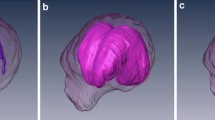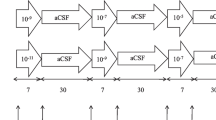Summary
Increased intracranial pressure due to brain oedema was produced in albino rabbits by combining a cryogenic lesion in the left hemisphere with the intraperitoneal administration of 6-aminonicotinamide (cytotoxic agent). The following parameters were assessed: intracranial pressure (ICP), systolic arterial pressure (SAP), central venous pressure (CVP), EEG, brain water and electrolyte content, gross pathology, and blood brain barrier integrity. Acute therapy to reduce ICP was performed by administering a bolus of mannitol (1 gm/kg) and 30 minutes later, also in bolus, frusemide (5 mg/kg). Immediately following the administration of mannitol an infusion of pentobarbitone was commenced; this was continued for one hour so that a total of 10 mg/kg was administered.
There was a 50% reduction of ICP at one hour from initiation of treatment. The brains of the animals were extracted immediately upon cessation of therapy (pentobarbitone) and they revealed a significant reduction of water content for the right, uninjured, hemisphere only, when compared to controls; a slight but not significant reduction of the brain sodium and potassium was noted in both hemispheres. There was no change noted in the gross pathology and extent of blood brain barrier breakdown. In all animals epinephrine infusion had to be administered for between 20 and 30 minutes to maintain a SAP over 80 torr. There seems to be no advantage in the simultaneous administration of barbiturates and diuretics for the control of ICP due to brain oedema.
Similar content being viewed by others
References
Astrup, J., Nordstrom, C. H., Rehncrona, S., Rate of rise in extracellular potassium in the ischemic rat brain and the effect of pre-ischemic metabolic rate: Evidence for a specific effect of phenobarbitone. Acta Neurol. Scand. (Suppl.)64 (1977), 146–147.
Baethmann, A., Reulen, H. J., Brendel, W., Die Wirkung des Antimetaboliten 6-Aminonicotinamid (6-ANA) auf Wasser- und Elektrolytgehalt des Rattenhirns und ihre Hemmung durch Nikotinsäure. Z. ges. exp. Med.146 (1968), 226–240.
Baethmann, A., van Harreveld, A., Water and electrolyte distribution in gray matter rendered edematous with a metabolic inhibitor. J. Neuropathol. exp. Neurol.32 (1973), 408–423.
Bakay, L., Haque, I. U., Morphological and chemical studies in cerebral edema: I. Cold induced edema. J. Neuropathol. exp. Neurol.23 (1964), 393–418.
Bruce, D. A., Langfitt, T. W., Miller, J. D., Schutz, H., Vapalahti, M. P., Stanek, A., Goldberg, H. I., Regional cerebral blood flow, intracranial pressure, and brain metabolism in comatose patients. J. Neurosurg.38 (1973), 131–144.
Bruce, D. A., Raphaely, R. C., Goldberg, A. I., Zimmerman, R. A., Bilamick, L. T., Schut, L., Kuhl, D. E., Pathophysiology, treatment and outcome following severe head injury in children. Child's Brain5 (1979), 174–191.
Clasen, R. A., Pandolfi, S., Casey, D., Jr., Furosemide and pentobarbital in cryogenic cerebral injury and edema. Neurology (Minneap.)24 (1974), 642–648.
Cottrell, J. E., Robustelli, A., Post, K., Turndorf, H., Furosemide- and mannitol-induced changes in intracranial pressure and serum osmolality and electrolytes. Anesthesiology47 (1977), 28–30.
Fenske, A., Samii, M., Reulen, H. J., Rey, O., Extracellular space and electrolyte distribution in cortex and white matter of dog brain in cold-induced oedema. Acta neurochir. (Wien)29 (1973), 81–94.
Go, K. G., Zijlstra, W. G., Flanderijn, A., Zuiderveen, F., Circulatory factors influencing exudation in cold-induced cerebral edema. Exp. Neurol.42 (1974), 332–338.
Harbaugh, R. D., James, H. E., Marshall, L. F., Shapiro, H. M., Laurin, R., Acute therapeutic modalities for experimental vasogenic edema. Neurosurgery5 (1979), 656–665.
Herrman, H. D., Neuenfeldt, D., Development and regression of a disturbance of the blood-brain barrier and of edema in tissue surrounding a circumscribed cold lesion. Exp. Neurol.34 (1972), 115–120.
James, H. E., Bruce, D. A., Welsh, F., Cytotoxic edema produced by 6-aminonicotinamide and its response to therapy. Neurosurgery3 (1978), 196–200.
James, H. E., Langfitt, T. W., Kumar, V. S., Ghostine, S. Y., Treatment of intracranial pressure. Acta neurochir. (Wien)36 (1977), 189–200.
James, H. E., Laurin, R. A., Intracranial hypertension and brain oedema in albino rabbits. Part 1: Experimental models. Acta neurochir. (Wien)55 (1981), 213–226.
Klatzo, I., Neuropathological aspects of brain edema. J. Neuropathol. exp. Neurol.26 (1967), 1–14.
Klatzo, L., Pathophysiological aspects of brain edema. In: Steroids and brain edema (Reulen, H. J., Schurmann, K., eds.), pp. 1–8. Berlin-Heidelberg-New York: Springer. 1972.
Klatzo, I., Piraux, A., Laskowski, E. J., The relationship between edema, blood-brain barrier and tissue elements in a local brain injury. J. Neuropathol. exp. Neurol.17 (1958), 548–564.
Klatzo, I., Wisniewski, H., Steinwall, O., Streicher, E., Dynamics of cold injury edema. In: Brain edema (Klatzo, I., Seitelberger, F., eds.), pp. 554–563. Wien-New York: Springer. 1967.
Langfitt, T. W., Increased intracranial pressure. In: Neurological surgery (Youmans, J. R., ed.), pp. 443–495. Philadelphia: W. B. Saunders. 1973.
Leech, P., Miller, J. D., Intracranial voluma-pressure relationships during experimental brain compression in primates: 3. Effect of mannitol and hyperventilation. J. Neurol. Neurosurg. Psychiat.37 (1974), 1105–1111.
Marshall, L. F., Smith, R. W., Shapiro, H. M., The outcome with aggressive treatment in severe head injuries. J. Neurosurg.50 (1979), 26–30.
Matsumoto, A., Kogure, K., Utsunomiya, Y., Busto, R., Scheinberg, P., Reinmuth, O. M., Energy metabolism and CBF in cold-induced brain edema: Comparison of the effect of dexamethasone under nitrous oxide and under pentobarbital anesthesia. In: Blood flow and metabolism in the brain (Harper, A. M., Jennett, W. B., Miller, J. D., Rowan, J. O., eds.), pp. 629–630. Edinburgh: Churchill-Livingstone. 1975.
Michenfedler, J. D., Theye, R. A., Cerebral protection by thiopental during hypoxia. Anesthesiology39 (1973), 510–517.
Miller, J. D., Volume and pressure in craniospinal axis. Clin. Neurosurg.22 (1974), 76–105.
Millson, Ch., James, H. E., Shapiro, H. M., Laurin, R., Intracranial hypertension and brain oedema in albino rabbits. Part 2: Effects of acute therapy with diuretics. Acta neurochir. (Wien)56 (1981), 167–181.
Reulen, H. J., Vasogenic brain oedema: New aspects in its formation, resolution and therapy. Brit. J. Anaesth.48 (1976), 741–752.
Schaul, N., Ball, G., Gloor, P., Pappius, H. M., The EEG in cerebral edema. In: Dynamics of brain edema (Pappius, H. M., Feindel, W., eds.), pp. 144–149. Berlin-Heidelberg-New York: Springer. 1976.
Shapiro, H. M., Intracranial hypertension: Therapeutic and anesthetic considerations. Anesthesiology43 (1975), 445–471.
Shapiro, H. M., Galindo, A., Wyte, S. R., Harris, A. B., Rapid intraoperative reduction of intracranial pressure with thiopentone. Brit. J. Anaesth.45 (1973), 1057–1062.
Shapiro, H. M., Wyte, S. R., Loeser, J., Barbiturate-augmented hypothermia for reduction of persistent intracranial hypertension. J. Neurosurg.40 (1974), 90–100.
Smith, A. L., Marque, J. H., Anesthetics and cerebral edema. Anesthesiology45 (1976), 897–901.
Vassallo, A., Cioffi, F., Strukelj, S., Il fursemid nel trattamento dell-edema cerebrale durante l'intervento chirurgico. Minerva Neurochir.15 (1971), 165–167.
Vernadekis, A., Woodbury, D. M., Electrolyte and amino acid changes in rat brain during maturation. Amer. J. Physiol.203 (1962), 748–752.
Wilkinson, H. A., Wepsic, J. G., Austin, G., Diuretic synergy in the treatment of acute experimental cerebral edema. J. Neurosurg.34 (1971), 203–208.
Wise, B. L., Chater, N., The value of hypertonic mannitol solution in decreasing brain mass and lowering cerebrospinal fluid pressure. J. Neurosurg.19 (1962), 1038–1043.
Author information
Authors and Affiliations
Rights and permissions
About this article
Cite this article
Millson, C.H., James, H.E., Shapiro, H.M. et al. Intracranial hypertension and brain oedema in albino rabbits. Part 3: Effect of acute simultaneous diuretic and barbiturate therapy. Acta neurochir 61, 271–280 (1982). https://doi.org/10.1007/BF01743871
Issue Date:
DOI: https://doi.org/10.1007/BF01743871




